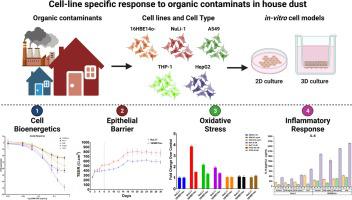Environment International ( IF 10.3 ) Pub Date : 2022-07-12 , DOI: 10.1016/j.envint.2022.107403 Mauricius Marques Dos Santos 1 , Megan Tan Pei Fei 2 , Caixia Li 3 , Shenglan Jia 3 , Shane Allen Snyder 4

|
Exposure to organic contaminants in house dust is linked to the development or exacerbation of many allergic and immune disorders. In this work, we evaluate the effects of organic contaminants on different cell bioenergetics endpoints using five different cell lines (16HBE14o-, NuLi-1, A549, THP-1 and HepG2), and examine its effects on lung epithelial cells using conventional 2D and 3D (air–liquid interface/ALI) models. Proposed rapid bioenergetic assays relies on a quick, 40 min, exposure protocol that provides equivalent dose–response curves for ATP production, spare respiratory capacity, and cell respiration. Although cell-line differences play an important role in assay performance, established EC50 concentrations for immortalized lung epithelial cells ranged from 0.11 to 0.15 mg/mL (∼2 µg of dust in a 96-well microplate format). Bioenergetic response of distinct cell types (i.e., monocytes and hepatocytes) was significantly different from epithelial cells; with HepG2 showing metabolic activity that might adversely affect results in 24 h exposure experiments. Like in cell bioenergetics, cell barrier function assay in ALI showed a dose dependent response. Although this is a physiologically relevant model, measurements are not as sensitivity as cytokine profiling and reactive oxygen species (ROS) assays. Observed effects are not solely explained by exposure to individual contaminants, this suggests that many causal agents responsible for adverse effects are still unknown. While 16HBE14o- cells show batter barrier formation characteristics, NuLi-1 cells are more sensitivity to oxidative stress induction even at low house dust extract concentrations, (NuLi-1 2.11-fold-change vs. 16HBE14o- 1.36-fold change) at 0.06 µg/mL. Results show that immortalized cell lines can be a suitable alternative to primary cells or other testing models, especially in the development of high-throughput assays. Observed cell line specific responses with different biomarker also highlights the importance of careful in-vitro model selection and potential drawbacks in risk assessment studies.
中文翻译:

细胞系和培养模型对室内灰尘中有机污染物的特异性反应:细胞生物能量学、氧化应激和炎症终点
暴露于室内灰尘中的有机污染物与许多过敏和免疫疾病的发展或恶化有关。在这项工作中,我们使用五种不同的细胞系(16HBE14o-、NuLi-1、A549、THP-1 和 HepG2)评估有机污染物对不同细胞生物能量学终点的影响,并使用常规二维和3D(气液界面/ALI)模型。提议的快速生物能量测定依赖于快速的 40 分钟暴露方案,该方案为 ATP 产生、备用呼吸能力和细胞呼吸提供等效的剂量反应曲线。尽管细胞系差异在测定性能中起着重要作用,但已建立的 EC 50永生化肺上皮细胞的浓度范围为 0.11 至 0.15 mg/mL(96 孔微孔板中约 2 µg 的灰尘)。不同细胞类型(即单核细胞和肝细胞)的生物能量反应与上皮细胞显着不同;HepG2 显示可能对 24 小时暴露实验结果产生不利影响的代谢活性。与细胞生物能量学一样,ALI 中的细胞屏障功能测定显示出剂量依赖性反应。虽然这是一个生理相关模型,但测量值不如细胞因子分析和活性氧 (ROS) 检测敏感。观察到的影响并不仅仅通过暴露于单个污染物来解释,这表明许多造成不利影响的原因仍然未知。虽然 16HBE14o- 电池具有面糊屏障形成特性,即使在低屋尘提取物浓度(NuLi-1 2.11 倍变化与 16HBE14o- 1.36 倍变化)在 0.06 µg/mL 时,NuLi-1 细胞对氧化应激诱导也更敏感。结果表明,永生化细胞系可以成为原代细胞或其他测试模型的合适替代品,特别是在高通量检测的开发中。观察到具有不同生物标志物的细胞系特异性反应也突出了谨慎的重要性体外模型选择和风险评估研究中的潜在缺陷。











































 京公网安备 11010802027423号
京公网安备 11010802027423号